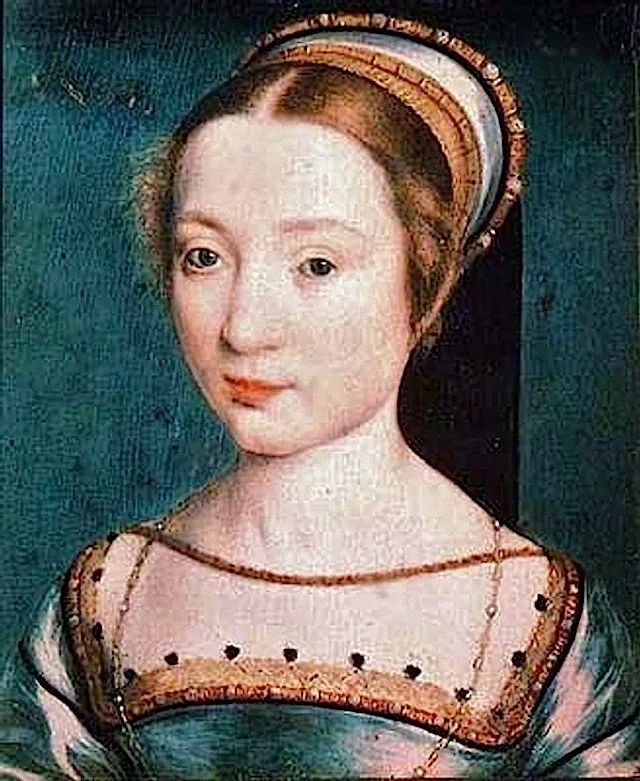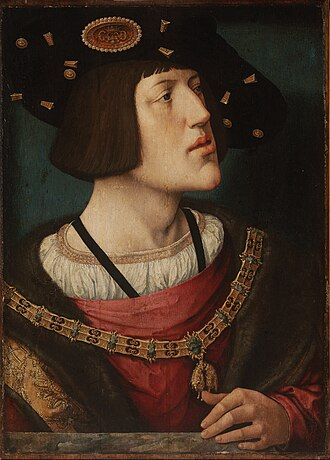MARGARET BEAUFORT
MATRIARCH OF THE TUDOR DYNASTY
Lady Margaret Beaufort
was the daughter of John Beaufort, Duke of Somerset. Somerset was the son of John
of Gaunt, son of King Edward III, and his mistress Katherine Swynford. Gaunt later
married Swynford and their children were made legitimate. Margaret’s mother was
Margaret Beauchamp, Duchess of Somerset. The Duchess gave birth to Margaret at
Bletsoe Castle in Bedfordshire, on 31 May in either 1441 or 1443.
Lady Margaret Beaufort, Countess of Richmond and Derby, Meynnart Wewyck, c. 1510
While the Duchess of Somerset
was preparing to give birth to Margaret, Somerset was preparing for a military
campaign in France. The campaign proved disastrous and led to a rift between
Somerset and King Henry VI. Somerset was banished from court pending charges of
treason. According to the Crowland Chronicle, Somerset committed suicide, one of
the worst sins of the time.
Upon Somerset’s death, as
his only child, Margaret was now a very wealthy heiress with a claim to the
throne. However, she was now a ward of the crown, which made the young Margaret a political pawn. Her wardship was first granted to William de la Pole, Duke of
Suffolk. Sometime between the ages of approximately 1-3, Margaret was married
to Suffolk’s son, John de la Pole. Three years later, the union was dissolved.
Margaret’s wardship was
then given to Edmund and Jasper Tudor. Edmund and Jasper Tudor were the half
brothers of King Henry VI. The boys had the same mother, Dowager Queen Catherine
of Valois, however, they had different fathers. King Henry VI’s father was King
Henry V, through Catherine’s first marriage. When King Henry V died, Catherine began
a relationship with Owen Tudor, a Welsh courtier. They married and Catherine
gave birth to three sons, two of which survived: Edmund and Jasper.
King Henry VI, Unknown, c. 1540, National Portrait Gallery, London
On 1 November 1455, Margaret
married Edmund Tudor. However, the newlyweds were living in political upheaval:
the Wars of the Roses had just begun. King Henry VI proved to be an inept king who suffered from a mental illness, comatose for months at a time. Not happy
with how Queen Margaret of Anjou was running the country in her husband’s absence,
factions at court began to fester. The leader of one such faction was Richard
Plantagenet, Duke of York. The Duke of York had been named Lord Protector during
the periods of Henry VI’s mental instability. When Henry VI recovered his
senses, York was pushed out of political power. He eventually made a bid for
the throne, claiming he was the rightful King, as he was a descendant of Anne
Mortimer, a descendant of Edward III’s second son. The Lancastrians were
descendants of Edward III through his third son, John of Gaunt. What then took
place was a cousin’s war we now refer to as the Wars of the Roses.

Richard Plantagenet, Duke of York, Talbot Shrewsbury Book, c. 1445
During the Wars of the
Roses, Edmund Tudor, a Lancastrian, was captured by the Yorkists. He died of
the plague while imprisoned in Carmarthen Castle on 3 November 1456. Less than
a year after their marriage, Margaret was now a thirteen-year-old widow, pregnant
with Edmund’s child.
Margaret travelled to Pembroke
Castle in Wales, to her brother-in-law, Jasper Tudor, for her safety. It was at
Pembroke Castle that Margaret suffered a long, excruciating birth. On 28
January 1457, Margaret gave birth to her son, Henry Tudor.
Not long after Henry’s
birth, Jasper arranged Margaret’s third marriage to Sir Henry Stafford, the second
son of the Duke of Buckingham. Their marriage seemed to be happy one. Henry
Tudor stayed behind with Jasper. Margaret was only able to visit him seldomly. When
King Edward IV was placed back on the throne, after the brief reinstallation of
King Henry VI, Margaret beseeched Jasper Tudor to take Henry abroad and flee
for their safety. Henry Tudor was the only remaining Lancastrian claimant to
the throne and, therefore, a target. Jasper agreed and it would be fourteen years before Margaret saw
her beloved son again.
In 1471, Henry Stafford died
of wounds he suffered during the Battle of Barnet, fighting for the Yorkist army.
At the age of only 28, Margaret was a widow twice over. Finally taking her fate
into her own hands, Margaret herself arranged her fourth and last marriage. In
a show of pure political astuteness, Margaret married Sir Thomas Stanley in
June 1472. By marrying Stanley, Margaret was able to return to court and put
herself into a position to petition King Edward IV and Queen Elizabeth Woodville
for the safe return of her son. Margaret must have played the role well, as
Queen Elizabeth asked Margaret to be a godmother to one of her children.
Henry Tudor was not able
to return home before the unexpected death of King Edward IV. Margaret would
have to advocate all over again with the new king, Richard III. It appears that
Margaret attempted to negotiate with Richard III during a closed doors meeting.
Richard III wasn’t having it- he saw Henry as a threat to his throne and would
not allow him to return to England alive. Afterall, Richard III usurped his nephew’s
throne, what was to stop Tudor from doing the same? It was at this point, in my
opinion, Margaret decided she would have her son home one way or another. The
best way to do that? Bring him home as the Lancastrian claimant to the throne
of England.
But how did Margaret go
about doing this? Margaret found a surprising ally in Dowager Queen Elizabeth
Woodville. The two corresponded via a mutual physician and orchestrated a plot
to bring Henry Tudor home, defeat Richard III in battle, and marry Edward IV’s eldest
daughter, Elizabeth of York, thereby uniting the families of York and Lancaster,
effectively ending the Wars of the Roses.
Queen Elizabeth Woodville, Unknown, after 1500, Queen's College
In 1483, Margaret was a
key figure in the Buckingham Rebellion. Henry Stafford, Duke of Buckingham,
ally and friend of Richard III, conspired with Margaret to remove Richard III
with force and replace him with Henry Tudor. Buckingham would have less to gain
with Tudor on the throne, so, in my opinion, it appears Buckingham was attempting
to dupe Margaret by using her military force and place himself on the throne.
Richard III was made aware of the rebellion and Buckingham was captured and
executed. Tudor was unable to arrive in time for the rebellion, so he was safe
in Brittany, for now.
Richard III was made
aware of Margaret’s part in the rebellion. She was placed under house arrest
and all her lands and property were transferred to her husband, Sir Thomas
Stanley. Strong-willed and stubborn as ever, Margaret found a way to correspond
with her son. Henry Tudor relied heavily on his mother to raise support for him
in England.
Margaret did just that.
Henry Tudor set sail for England in August 1485. He landed at Mill Bay at the
mouth of Milford Haven in Pembrokeshire, Wales. Tudor made his way across England
and arrived at Market Bosworth. The ensuing battle would become known as the
Battle of Bosworth, with the underdog, Henry Tudor, emerging victorious. The battle
was not initially going well for Henry, but due to Margaret’s astute political prowess,
the Stanley family came swooping in, securing Henry’s victory.
King Henry VII, Unknown, c. 1505-1509
Margaret was now “My
Lady, the King’s Mother” and she signed her letters, Margaret Regina. During King
Henry VII’s first parliament, Margaret’s attainder was lifted (for treason
against Richard III) and she was declared feme sole- Margaret was now a woman
in her own right. Margaret used her many
powers for charitable acts and the furtherment of education. In 1499, Margaret took
a vow of chastity and began to live separately from her husband. Stanley visited
her often at her home of Collyweston, complete with separate rooms for his
personal use. Margaret was instrumental in arranging the marriages of Arthur
Tudor, Prince of Wales to Catherine of Aragon, as well as Princess Margaret
Tudor to King James IV of Scotland. Perhaps in remembrance of her own
suffering, Margaret advocated for the delay of Princess Margaret’s arrival in
Scotland, as she was too young to consummate the marriage.
Margaret outlived her
beloved son, Henry VII. He died on 21 April 1509 and Margaret was named the
executor of his will. Margaret was influential in securing the smooth
transition of power from Henry VII to her grandson, King Henry VIII. She also
planned her son’s funeral and Henry VIII and Queen Catherine of Aragon’s joint
coronation.
King Henry VIII, after Hans Holbein the Younger, after 1537
Margaret was the matriarch
of the Tudor Dynasty. She was a key figure during the Wars of the Roses and
lived an extraordinary life, paving the way for female agency in the early
modern period. Margaret lived through her son’s death and saw the coronation of
her grandson, King Henry VIII. A mere five days after her grandson’s
coronation, Margaret peacefully slipped from this world, knowing she did
everything she could for her son’s kingdom and also secured the first successful
transition of monarchical power in nearly a century.
John Fisher, Bishop of
Rochester, and a dear friend of Margaret’s, performed her last rights on 29
June 1509. In as perfect an end as the incredibly pious Margaret could pray
for, Bishop Fisher elevated the host and Margaret breathed her last.
Bishop John Fisher, Hans Holbein the Younger
Margaret Beaufort,
Countess of Richmond and Derby, was buried in the Henry VII Chapel in
Westminster Abbey, near her son and daughter-in-law, King Henry VII and Queen
Elizabeth of York. Separated for most of their lives, Margaret and Henry spend
the rest of eternity in close proximity.















.jpg)








